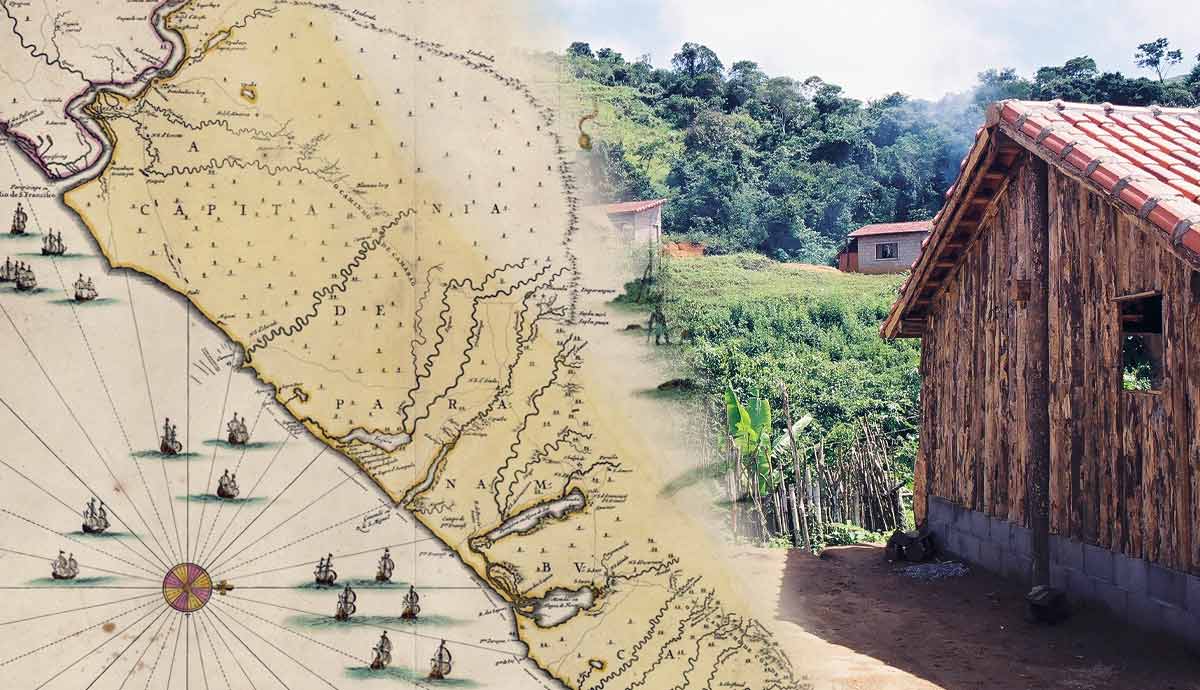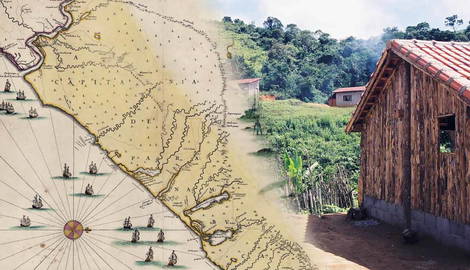
Enslaved Africans in Brazil who managed to escape the plantations and harsh labor systems took refuge in difficult-to-access areas outside of Portuguese control and formed communities, quilombos. Here, they not only managed to survive but also to rebuild the social and cultural structures of their African roots. Over time, they also developed alternative models of sustainable development. These quilombos, which endure to this day, have become a symbol of both freedom and resistance.
Brazilian Slavery and the Emergence of Quilombos

The first centuries of colonial occupation in the Americas were accompanied by the rapid imposition of slavery. At first, colonizers in the Americas, mostly Spaniards and Portuguese, forced the Indigenous population into labor. However, due to the new diseases brought by Europeans, the exhaustive working conditions, and the rampant violence against them, many ended up dying, decimating a large part of the Indigenous population.
It was deemed necessary to import African slaves to carry out work in mines and on plantations, initiating the transatlantic slave trade, a network between Africa, Europe, and the Americas, bringing enslaved Africans to the Caribbean and the rest of the American continent. In Brazil, the discovery of alluvial gold on the banks of the Ribeira de Iguape River lured prospectors, known as garimpeiros, to the frontier in the mid-seventeenth century. São Paulo’s first group of West African slaves arrived as laborers for the emerging gold rush.

As soon as the slaves began to arrive, they sought to escape, actively resisting the inhumane labor conditions, violence, and oppression. Geography worked in their favor, as mountainous regions, dense forests, rivers, caves, and cliffs provided hiding spots difficult for colonial authorities to find. Ingeniously, escaped slaves began to establish clandestine villages near tropical forests and along riverbanks, which allowed them a degree of independence. In this way, they not only escaped the slave system but also rebuilt social, cultural, religious, and economic structures similar to their African roots. They offered an alternative to the slave-plantation system based on communal ownership of land and family labor.
During the colonial period, references to these settlements can be found in Brazil as early as the 16th century under the name mocambos and, from the late 17th century, as quilombos. These terms originated in Central Africa and referred to camps or villages. Quilombos can be defined as communities of fugitive slaves that were formed in various parts of Latin America and the Caribbean, with the majority of them located in Brazil.
Way of Life in the Quilombos

Quilombos were generally divided into two areas: the residential space, where family homes were surrounded by a garden and areas for raising pigs and fruit trees, and the communal farming areas known as capuovas. These agricultural plots were part of a shifting cultivation system, where some areas were used communally while others were distributed among families based on the rule that whoever cleared and farmed the land had the right to use it as long as needed. Additionally, they had mobile huts made from easily accessible materials like wood and straw, allowing farmers to stay near the crops during planting seasons, intense work periods such as weeding, or when it was necessary to move to a new plot. These huts were easily dismantled and relocated, reinforcing a sense of collectivity, self-sufficiency, and respect for nature.
Due to their remote and isolated locations, the production of basic food supplies was indispensable for ensuring sustainability and independence. As a result, they developed a system based on staple crops, which are essential for a community’s diet and provide the bulk of its calories and nutrients. Unlike the monocultures worked by former slaves, quilombos practiced polyculture using ancestral methods like crop rotation and slash-and-burn farming. Among the most important foods in their diet were rice, beans, corn, cassava, and sweet potatoes.

The case of cassava is particularly interesting, as it was considered a staple food in Brazil, especially for African slaves and Indigenous peoples. Often referred to as the “Brazilian bread,” its durability made it a vital resource for long journeys. Moreover, it played a fundamental role in the quilombos’ economy, where cassava was planted and later harvested, ground, sieved, and baked into flour and other derivatives.
Cassava had the additional advantage of being a root crop that could be left in the ground, making it nearly invisible and discreet—a critical feature for these fugitive slave communities that needed to avoid detection by colonial authorities. This tuber could remain underground for long periods, acting as a natural pantry, which also provided the freedom to move and eat as needed. Lastly, in these remote and hostile areas, cassava required little maintenance and was highly resilient. This demonstrates how the relationship between people and crops extends far beyond a simple agricultural choice. In this case, it became a tool of resistance and freedom.
History of Quilombo dos Palmares

One of the most emblematic quilombos was Palmares, which began in the mid-16th century in what are now the states of Pernambuco and Alagoas. This refuge was more than a survival gathering or a hiding place; it became a symbol of struggle and resistance that endures to this day. Its social organization, based on communal structures and collective leadership, set an important precedent in the fight for the rights, dignity, and autonomy of Afro-descendant communities in Brazil.
It was common for quilombos, such as Palmares, to be established in interior regions of the continent, far from Portuguese control and difficult to access. The Portuguese, in turn, concentrated their presence along coastal areas where plantations, particularly sugar—their main export product—were located. Being close to the sea also facilitated the transportation of goods to Europe and the maintenance of slave trade routes. Moreover, due to the challenges of access and lack of economic incentives, colonial authorities rarely ventured into the continent’s interior, making these regions ideal refuges for fugitive slaves. These escapees took advantage of the natural protection offered by the wilderness, with its remote and difficult-to-navigate paths.

The Dutch invasion and the resistance of the Luso-Pernambucans allowed a significant number of slaves to escape from the sugar mills to Palmares. After the Dutch expulsion, the destruction from the war left the plantations weakened, while Palmares flourished as a refuge for free slaves, even forming a quilombo confederation, a rudimentary state, under the leadership of Ganga-Zumba. At its peak, this community of former slaves reached a population of 20,000, a surprising number considering that Rio de Janeiro had only 7,000 inhabitants at the time.
Colonial authorities carried out various attacks and military expeditions, though with very little success, as the internal cohesion of the quilombos allowed them to repel the assaults. Plantation owners had to restart the costly importation of African slaves, ultimately accepting a kind of truce. However, it did not last long; the intensity of the attacks on Palmares revealed the inability of the slaveholders to coexist with an organization of free producers and the internal cohesion of the Palmares formation.

After multiple encounters and battles between both sides, by the late 1670s, the war had tilted in favor of the colonists. As a result, leader Ganga-Zumba accepted the amnesty offered to him, a decision that sparked strong opposition among the quilombo inhabitants, fracturing the unity that had been so crucial. Shortly after, Ganga-Zumba was poisoned, and his nephew Zumbi, a prominent leader in previous offensives, took command. Zumbi refused to accept any deals.
The colonial authorities had to change their strategy and join forces to launch a major offensive. In 1694, an army of 9,000 men besieged the quilombo of Macaco, the largest at the time. After weeks, the technological superiority of the artillery and colonial organization eventually prevailed: powerful cannons destabilized the confrontation, the quilombo was devastated, and the battles turned into a massacre. Zumbi was captured, and his head was severed and displayed on a pole until it rotted. Despite the defeat and the definitive end of the Quilombo dos Palmares, it marked a milestone in the struggle for freedom. Today, Zumbi remains a symbol of resistance, and his death is commemorated in Brazil as Black Consciousness Day.
The Quilombo Legacy

The quilombos emerged as a means of survival; however, they also became a space and symbol of freedom and resistance against the oppressor. They confronted not only the slave system but also transformed the landscape in ways that challenged the plantation and mining economies central to Brazil’s social, political, and moral order. These communities were not idyllic scenes of equality, as they also reproduced internal power dynamics, but they symbolized the constant struggle for autonomy in the face of a deeply rooted slave system in Brazil for over three centuries.
Quilombos have remained to the present day, with the abolition of slavery in 1888 and the constitutional recognition of their rights in 1988. They continue to keep their cultural roots alive, a fusion of African, mestizo, and Indigenous influences, with an alternative model of sustainable development based on the respectful use of natural resources, family agriculture, low-impact farming, and ancestral knowledge. They emerged as a response to historical exploitation dynamics and a colonial extractivist model, but today, they reflect the ongoing relevance of spaces like these as grounds for resistance and reclamation in current socio-spatial struggles, linking their campaigns with contemporary demands for environmental justice and those of their ancestors for land and subsistence rights. They have not only reclaimed their history but also offer an alternative, more just, and environmentally friendly future.










